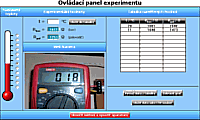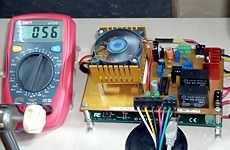Apparatus
Measurement Principle
The following measuring principle is based on a gradual cooling and heating of two elements. The first is a platinum resistance sensor whose resistance increases linearly with temperature. The second element is a thermistor, a semiconductor device whose resistance decreases exponentially with temperature. The change in temperature of the two elements provides the so-called Peltier cells, one side of the current passage is always cool and the other heats up. This allows us to change the size and direction of the flow to achieve different temperatures. In our attempt to achieve an approximate temperature range from -5 °C to 65 °C (depending on the conditions in the laboratory). The right image shows the view of the experimental device attached thermometer.
Both sensors are selected so that at room temperature was approximately the same resistance (about 1 kΩ). Resistances of both components are measured and displayed ohmmeter connected directly to the panel remote tasks on the website of the experiment. The temperature of both sensors is measured using a thermometer and a digital display showing the thermometer, which together with a task monitor user with a webcam.

The measurement is performed in such a way that the temperature of the Peltier cells is always set (12 values to be prepared). After stabilizing the temperature and resistance values of elements subtract the actual value of temperature from a web camera in the form and sends the measurements in the table – see on the left. Values in the table can be displayed directly on a web page in a graph or downloaded to your computer, where they can be further processed. The selected file format is CSV* – the file can be easily loaded in MS Excel and OO Calc. We can process data in the spreadsheet as needed. We can also further process the presented results.
* A CSV file is a standard text file in which columns of data are separated by semicolon
Video tutorial
TURN ON THE SUBTITLES IN THE VIDEO TO SEE THE DESCRIPTION AND EXPLANATIONS!







